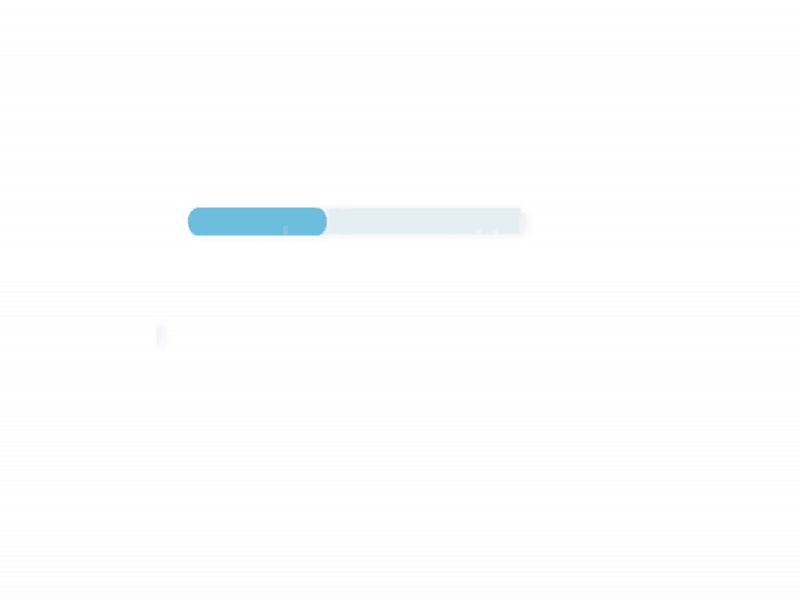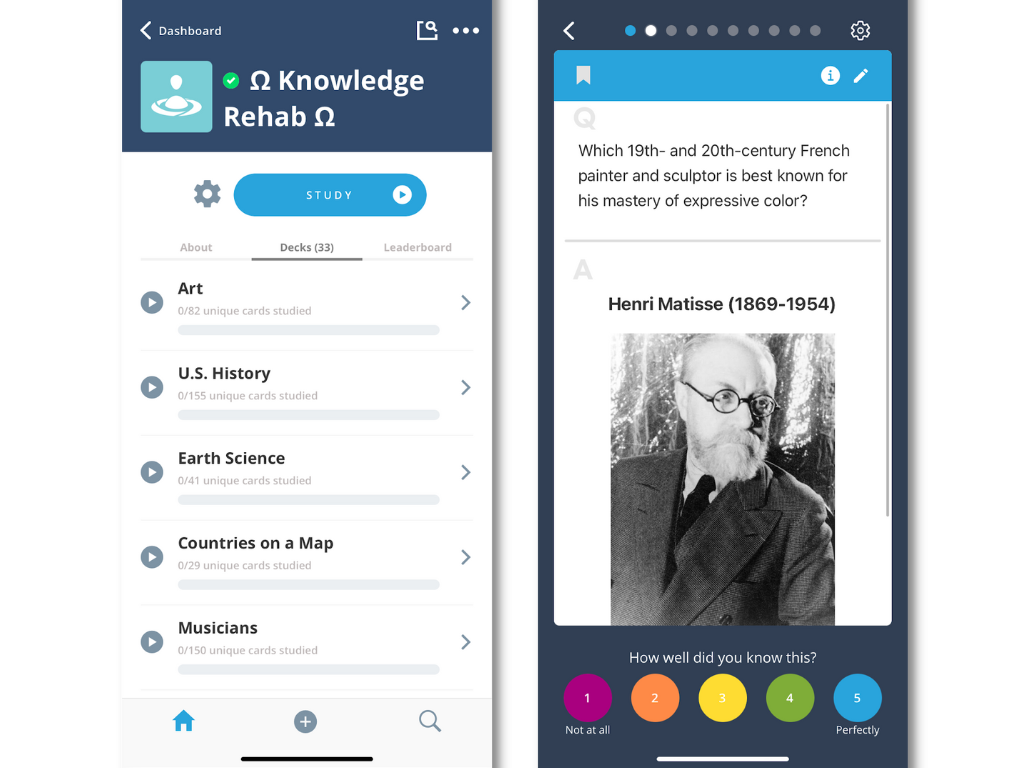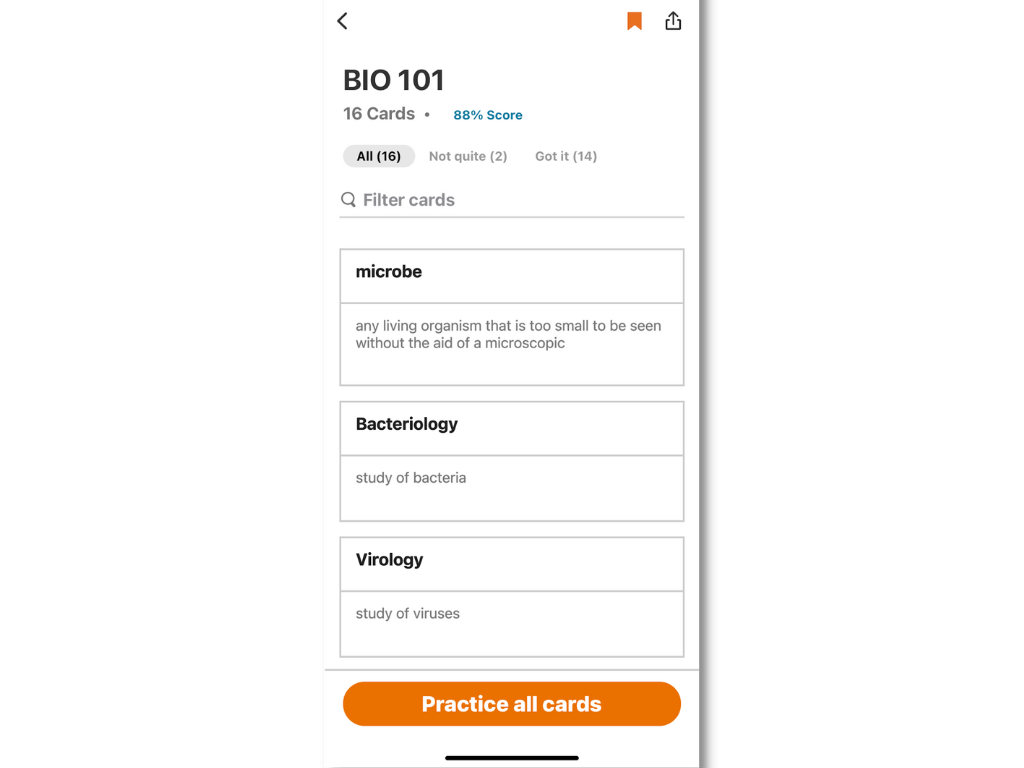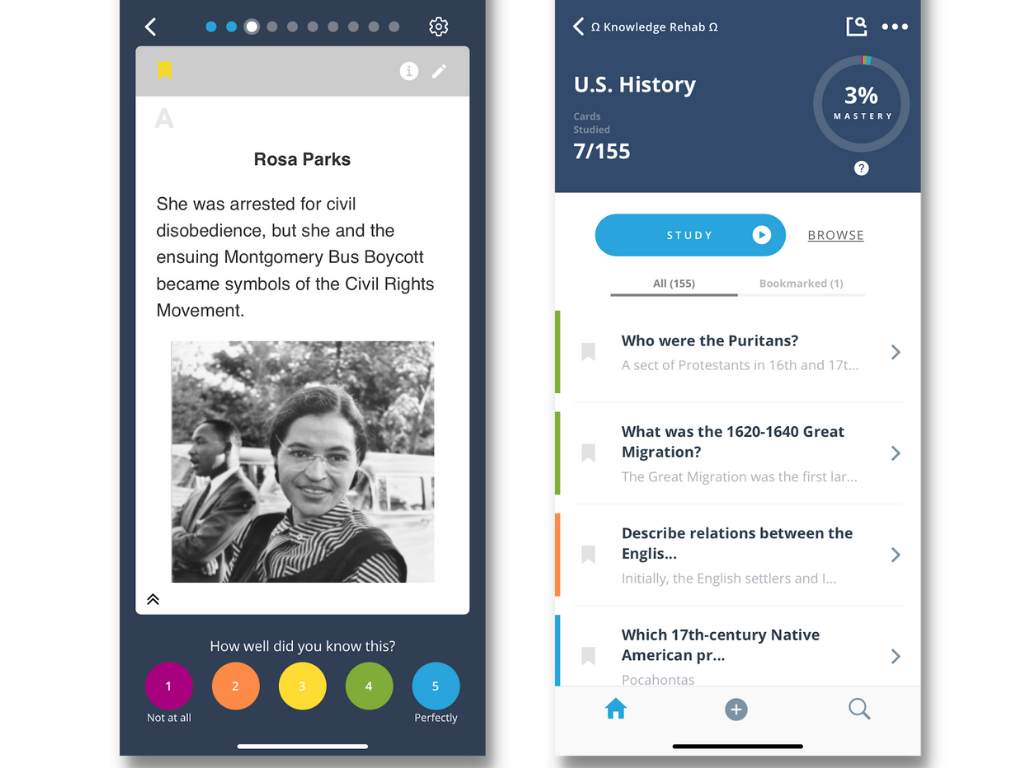You know that scene in The Matrix where Neo gets plugged into a machine and then magically wakes up and says, "I know kung fu"?
Spaced repetition systems (SRSs) are the closest that scientists have gotten to injecting your brain with knowledge that efficiently.
In a nutshell, SRS algorithms are learning tools that determine the frequency of each concept’s repetition based on the user's performance. More difficult concepts are repeated more frequently, while well-known concepts are repeated less frequently as the knowledge becomes ever more permanent.
Spaced repetition is proven to optimize a learner's study time more significantly than almost all other study "hacks" combined, including mnemonics, stories, gamification, and mental imagery.
In this article, we address more of the technical nuts and bolts behind four popular spaced repetition algorithms—(1) absolute SRS algorithms, (2) relative SRS algorithms, (3) manual SRSs, and (4) hard-coded spaced repetition—and how to determine which type of SRS is right for you.
Spaced Repetition as a "Feature"
One of the most common—but often overlooked—forms of spaced repetition is the kind built directly into larger online curriculum platforms rather than standalone SRS (spaced repetition system) tools.
For example, many online courses and e-textbooks incorporate built-in repetition through multiple-choice quizzes at the end of chapters. Incorrect answers tend to reappear more frequently until the user selects the correct one, reinforcing the material over time.
Similarly, study apps like Quizlet and Duolingo introduce some level of intelligent repetition within their exercises—such as matching, multiple-choice, or fill-in-the-blank questions—where tricky concepts show up more often in later lessons. While this approach isn’t as sophisticated as a dedicated spaced repetition system, it provides passive reinforcement that helps learners improve over time.
For many students, this built-in repetition is enough to achieve their learning goals. However, more serious learners often seek greater flexibility:
- Active recall instead of passive multiple-choice
- Self-assessed confidence ratings to refine the repetition algorithm
- The ability to add personal notes and flashcards into their study routine
Unfortunately, most all-in-one curriculum platforms don’t prioritize these advanced study features—their focus is on delivering structured lessons rather than optimizing personalized, long-term retention. That’s where dedicated SRS tools like Brainscape come in, giving learners full control over their study experience.
Spaced Repetition as a Product
For this reason, dedicated web and mobile SRS apps have independently evolved to supplement larger all-in-one digital curricula whose spaced repetition flexibility falls short. These powerful standalone study tools offer spaced repetition as the core feature rather than an afterthought.
Let’s now look at the FOUR popular algorithms these platforms use so that you can choose one that works best for you…
1. Absolute SRS Algorithms (e.g. Anki)
The main benefit of developing an independent learning system completely centered around spaced repetition flashcards is that it frees software designers' minds to focus on the more precise details of the adaptive study experience itself.
The first and most famous of these focused SRS flashcard apps was SuperMemo, developed by Piotr Woźniak in 1985 in Poland and maintained until the present day.
The desktop SuperMemo (SM) software uses an "absolute" SRS algorithm, meaning that it specifies an exact date and time at which each flashcard should be repeated, based on parameters including the user's self-rated confidence rating in the card.
If a SM user returns to study the deck at an earlier time than any cards are "due" for a repeat, they are told that there are no cards to study today and that they should return at a later date.
Unfortunately, this doesn't allow for packing in extra study, or missing a day and catching up.
The popularity of SuperMemo has inspired several derivative absolute SRS apps over the years, the most notable of which has been Anki, a free desktop and mobile app developed by Damien Elmes using a modified version of the SM-2 algorithm.
Anki's "open source" nature allows other software developers around the world to customize the study algorithm (among other features) and contribute "add-ons" that afford a nearly infinite range of personalizations for different types of studiers.
Anki has since become extremely popular among life hackers, quantified-self enthusiasts, and other "do-it-yourself" learners who prefer a high degree of control over their study optimizations, even if it means having to do a bit of extra work. The /r/anki subreddit is indeed a vibrant forum where the world's autodidacts can compare tips, hacks, and add-ons with fellow users.
2. Relative SRS Algorithms (e.g. Brainscape)

Of course, not everyone is willing to invest hours into configuring their study technology. Many of us mere mortals prefer a simpler user interface that lets us dive straight into studying. In fact, removing the cognitive load of organizing your study sessions frees up brain space to learn more efficiently.
For this reason, Brainscape (and other mobile flashcard apps) have developed SRS software that determines the likelihood of each card's repetition based on the user's relative confidence rating rather than setting an absolute date and time for repetition.
For example, if a user rates a Brainscape flashcard a "5" (perfect confidence), the algorithm will mark it as less likely to repeat than other cards but will not precisely schedule it for a predetermined date. A user who has rated all cards in a deck as a "5" will accordingly be able to continue studying that deck of 5s (and potentially downgrading as needed) even though theoretically, they may not have "needed" to review those cards again quite so soon.
This relative, rather than absolute, flashcard spacing has the following advantages:
- It absolves the flashcard author from having to determine each card's "easiness factor" (and rather leaves it to the learner to dynamically determine the relative confidence and difficulty of each card, which can vary between learners and over time).
- It absolves the learner from having to set their preferred inter-repetition study intervals. Example: deciding that a confidence rating of "2" should mean "one day from now", etc.
- It allows a user to easily "cram" a deck or class one last time before an exam, even if many/most highly rated cards technically aren't scheduled for review until later.
- It provides leeway for learners to work studying into their busy day rather than the inverse. Example: If I happen to have four hours available to study today but only five minutes tomorrow, then I can still study as much as I have time for right now, rather than being locked out because my card repeats aren't "due" yet.
- It permits the relative SRS's analytics to estimate your net amount of study time remaining (e.g. 3 hours, 14 minutes) that you can spread over time as it's convenient for you, rather than just telling you that you have 17 weeks remaining (if you were to study the perfect precise amount every day).
- It is more amenable to a "progressive" learning path that encompasses many decks at once, rather than the user having to choose which deck to study every time. This process automatically opens up new (not-yet-seen) cards and decks only as the user is ready for them, based on their cognitive load.

This last point is particularly important as it presents a single ongoing progressive study experience in which new concepts are only introduced as the learner's pace allows.
Brainscape is able to do this by running a "fresh" version of the algorithm every time a new card is selected for studying. The algorithm first chooses which confidence "bucket" to choose a card from, but where the 1 bucket ("hardest" cards) is combined with the New Cards bucket to trigger a special subroutine whenever the "New/1" bucket is selected.
This subroutine allows Brainscape to dynamically determine the pace of introduction of new cards depending on the learner's existing cognitive load.
If there are many cards already rated as a "1", then Brainscape avoids introducing new material until enough cards have been upgraded to higher levels of confidence. This helps preserve the learner's limited working memory and prevents them from becoming discouraged.
By dynamically determining a user's readiness for new flashcards, Brainscape saves you from choosing which deck to study, instead giving you one single Study button for a class or even your entire library of flashcards.
The algorithm will then intelligently determine the right time to begin introducing cards from the next deck, keeping learners on the fringe of the zone of proximal development.
3. Manual Spaced Repetition Systems
Another type of SRS isn't an automated algorithm but an analog method to implement spaced repetition on your own, such as paper flashcards.
As you study them, you might manually sort cards into your "easy pile" and "hard pile", after which you would likely focus more of your attention on the harder pile. This has traditionally been known as the Leitner method.
This natural learning behavior has now been replicated by basic digital flashcard apps, such as Chegg Prep and Cram, that don't offer automated, progressive spaced repetition but rather allow the user to mark each flashcard as "Got it" or "Not Quite", after which point they can filter for just the "Not Quite" cards until mastery.

Of course, some automated SRS flashcard platforms (like Brainscape) allow for such manual spaced repetition as well, as an alternative to their main absolute or relative SRS algorithm.
Brainscape, for example, offers a "bookmark" button in addition to the 1-5 confidence options, allowing users to flag particular flashcards to come back to later. This can not only be used for manual spaced repetition but can also be used to flag concepts to discuss with a tutor or peer.

For small amounts of content and for specific circumstances, manual spaced repetition tools like these can be very helpful for learners of many subjects.
4. "Hard-Coded" Spaced Repetition
Some types of learning formats are non-adaptive by nature. For example, a video or audio playlist is "linear" and does not have customizable spaced repetition based on each learner's mastery of each individual learning objective within the curriculum.
But despite this lack of adaptivity, some video/audio curriculum designers have still endeavored to inject spaced repetition into the material itself, even if it's "one-size-fits-all." For example, in a Spanish video playlist, each new lesson might still drop in occasional reviews of the concepts taught in previous lessons, gradually decreasing the frequency of review of earlier items as they're solidified in the learner's memory.
We call these spaced repetition curricula "hard-coded" because:
- They still involve one of the core principles of spaced repetition (gradually increasing the interval between the review of each item) but:
- They are not in any way intelligent (adaptive) in the way that they determine the interval of repetition. In other words, they are not customized to the learner.
Probably the most famous "hard-coded" spaced repetition curriculum is the Pimsleur Method. A brilliant tool for passive learning, the Pimsleur Method helped pioneer pre-adaptive spaced repetition through the production of engaging foreign language educational recordings.
From records to audio cassettes to CDs to today's MP3s, Pimsleur has helped millions of people learn languages via conversational audio playlists, which progressively add new concepts in each lesson while keeping previous lessons' concepts refreshed.
Such hard-coded spaced repetition can be an extremely effective way to leverage this powerful learning phenomenon for audio and video series where the curriculum is "linear" and passive.
FAQ: Comparing Spaced Repetition Algorithms
What is the best method of spaced repetition?
The best method depends on your goals and study habits. If you want precision and don’t mind setup, an algorithmic approach like SM-2 (used by Anki) can be highly efficient. If you value flexibility and simplicity, a confidence-based system like Brainscape may better support consistent long-term learning. The “best” method is the one you’ll actually use consistently.
Is FSRS better for Anki?
FSRS (Free Spaced Repetition Scheduler) is a newer, more customizable algorithm designed to improve scheduling precision in Anki. It's popular among power users who enjoy tweaking parameters to fit their learning style, but it adds complexity. Whether it’s “better” depends on your preferences for control versus simplicity.
What is SM-2 spaced repetition algorithm?
SM-2 is the classic algorithm created for SuperMemo in the 1980s. It calculates the exact intervals for card reviews based on user feedback. It’s the backbone of many modern SRS apps like Anki and was one of the first systems to automate personalized review timing for maximum retention.
What is 2/3, 5/7 spaced repetition?
This refers to a basic spaced repetition pattern where you review material after 2 or 3 days, then again after 5 or 7 days. It’s a simplified version of spaced repetition used in manual study schedules. While not as personalized or adaptive as algorithmic systems, it still improves recall better than cramming.
Which Type of SRS Algorithm Is Best?
Forgive us for this clickbait-y heading, but none of the three types of SRS algorithms are objectively "better". It all depends on:
- The amount you need to learn,
- Your appetite for manual configuration, and
- Your style of studying.
It is probably true that—in a perfect world where you are studying at the exact right time every day, and in the exact right amounts—an absolute SRS algorithm like Anki will provide a more precise and efficient use of study time than a relative SRS algorithm (and certainly more than a manual study system will).
It's also probably true that a relative spaced repetition algorithm like Brainscape will be more convenient and flexible for users who don't have the patience for many configurations or precise daily scheduling.
It's up to the learner to determine whether such precision of an absolute algorithm is worth the tradeoffs in terms of extra setup work and user experience.
The bottom line is that any SRS algorithm is already exponentially more effective than traditional "linear" study methods (such as reviewing highlighted notes, re-watching lectures, or taking multiple-choice practice tests). Comparatively, the difference in card-repetition efficiency between the automated SRS algorithms themselves is vanishingly trivial.
Do you have questions/comments/opinions? Want to ask us for more details? Join the conversation on the Brainscape subreddit.
Additional Reading
References
EduWW. (2023, December 3). Why Self-Paced Learning is Good For Students. Education World Wide. https://eduww.net/online-learning-tips/self-paced-learning/
Jankowski, J. (2022, November 2). Application of a computer to improve the results obtained in working with the SuperMemo method - SuperMemo. SuperMemo. https://www.supermemo.com/en/blog/application-of-a-computer-to-improve-the-results-obtained-in-working-with-the-supermemo-method
MindEdge. (2021, May 21). The Leitner System: How Does it Work? https://mindedge.com/learning-science/the-leitner-system-how-does-it-work/
Murad, Z., & Starmer, C. (2021). Confidence snowballing and relative performance feedback. Journal of Economic Behavior & Organization, 190, 550–572. https://doi.org/10.1016/j.jebo.2021.08.006
Simon & Schuster. (2024). Our language learning method. Pimsleur. https://www.pimsleur.com/the-pimsleur-method/
Smith, C. D., & Scarf, D. (2017). Spacing repetitions over long timescales: A review and a reconsolidation explanation. Frontiers in Psychology, 8. https://doi.org/10.3389/fpsyg.2017.00962
Traverse. (2023, October 2). Supercharge your Memory and Understanding. https://traverse.link/spaced-repetition/spaced-repetition-system-software
